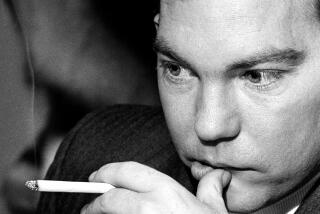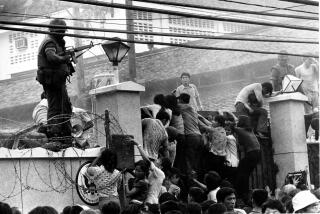Tet Becomes Holiday Again in Vietnam, Not War’s Crucial Battle
HUE, Vietnam — Thirty years ago Saturday, Communist forces launched a predawn attack that would change the course of the Vietnam War. The magnitude of the Tet Offensive reached a stunned U.S. officialdom with five simple words: “Sir,” said the Marine guard who awoke Ambassador Ellsworth Bunker at 3 a.m., “Saigon is under attack.”
From the DMZ to the Mekong Delta, hell broke loose on the Lunar New Year, with heavy fighting engulfing 100 of South Vietnam’s provincial and district capitals.
Here in Hue, which was in northern South Vietnam, Col. Nguyen Quoc Thanh’s guerrillas hoisted the Viet Cong flag over the historic Citadel. It would fly there for 26 days, until U.S. Marines retook the city, inch by inch.
The hot-tempered Thanh was nicknamed “Lua”--fire in Vietnamese--during the war. But today, at 67 and retired from a 33-year military career, Thanh is the ultimate gracious host to Americans come calling at the small hotel he runs a few blocks from the Perfume River. Over a cup of tea, he said he has long since put the Tet Offensive and his hatred of Americans behind him.
So has Vietnam itself. The 30th anniversary of the offensive has received no mention in the media here and is being treated as a nonevent. For Vietnam, Tet once again represents a family holiday--the most special holiday of the year--and is no longer associated with a war the Vietnamese have tried to forget.
“We never looked down on the American troops,” said Thanh, the former deputy commander of the Communists’ 6th Regiment. “They were well trained. They fought hard, and, after the Russians, they had the best military technology in the world.
“But the difference was, we had the support of the people. I used to come into Hue easily to scout our targets before Tet,” he said. “If security was a problem, I’d come in at night and the village people would look after me. I knew them all. I was born here.
“Our goal was to destroy Saigon’s control over the people and get the Americans involved so we could eliminate some platoons and reach the American public,” he said. “We wanted to force the Americans to sit and make an accord with us.”
The Viet Cong, the anti-Saigon Southerners, suffered devastating losses during Tet--an estimated 58,000 dead (compared with 3,893 American and 4,954 South Vietnamese dead). The Viet Cong infrastructure never recovered, and increasingly the burden of fighting was borne by North Vietnamese regulars.
Thanh dismissed with a laugh the widely held perception that Tet--though perhaps a psychological victory because it solidified anti-war sentiment in the United States--was a military defeat for the Communists.
“For us, it was just one battle among many. We can say we won; you can say you won. But when all is said, whose flag do you see there?” he asked, nodding toward a red Vietnamese flag with a gold star flying from his hotel’s balcony.
The morning the offensive began, Lt. Col. Robert Gard reported for work in the Pentagon as usual at 7 a.m. His job was to go through overnight intelligence cables from Vietnam and decide which ones to send on to his boss, Defense Secretary Robert S. McNamara. Gard did a double take. The stack of cables on his desk seemed a yard high.
“Shock was what I remember our initial reaction being,” said Gard, now president of the Monterey Institute of International Studies in Monterey, Calif. “There were cables from all over the country--Saigon, Da Lat, Pleiku, Da Nang, Nha Trang, Hue--and they all said the same thing. They were under attack.”
The North Vietnamese port of Haiphong, where Bob Eaton, an American and a Quaker, had arrived the day before with a shipment of medicine for civilians, was abuzz. Residents walked in the streets with transistor radios pressed to their ears, listening to news reports of the offensive from the U.S. Armed Forces Radio, broadcast in English from South Vietnam.
“The network was run by the military for American troops, but the North Vietnamese thought it provided the most accurate reporting of the war,” said Eaton, now director of humanitarian programs for the Vietnam Veterans of America Foundation in Washington. “Someone in Haiphong said: ‘The Americans aren’t going to have a sense of humor about this. They’ll level the city. You better get out.’ ”
In Saigon, the Viet Cong began filtering into the city the night of Jan. 30, under cover of firecrackers as the capital celebrated the new year. (Firecrackers are banned during Tet celebrations now as wasteful and dangerous.) Their first stops were the graveyards where weapons were buried in coffins--thus explaining the large number of “funerals” that had been held in Saigon before Tet.
Not until several hours after Ambassador Bunker had been awakened and hustled off in an armored carrier to a safe house in Saigon, wearing only a bathrobe over his pajamas, did the extent of the Communists’ offensive become clear. Among the targets was the U.S. Embassy, which 19 barefoot commandos breached before being killed in a fierce firefight.
Tet shocked the American public and led to profound political changes: Public sentiment against the war grew, support in Congress waned, protests spread. Support for President Lyndon B. Johnson’s handling of the war fell from 40% before Tet to 26%. On Feb. 27, 1968, CBS-TV anchor Walter Cronkite said it was “more certain than ever that the bloody experience of Vietnam is to end in a stalemate.”
For reasons she can’t quite explain, Patricia Walsh, 55, chose the 30th anniversary of the offensive to confront the nightmares she still has about Tet. She came back to visit the civilian hospital in Da Nang where she was a nurse and where patients were stretched out in corridors and on porches during Tet. Three doctors conducted 100 or more major operations every day for days on end. “It’s a trip I never thought I would make,” she said.
Walsh, now a Boulder, Colo., filmmaker and author, left Vietnam in June 1968 weighing 82 pounds. The United States she returned to seemed ablaze. Martin Luther King Jr. had been killed. So had Robert F. Kennedy. Protesters filled the streets, and no hero’s welcome awaited returning GIs.
“How does one come home from war when the home you left is no longer there?” she asked.
More to Read
Sign up for Essential California
The most important California stories and recommendations in your inbox every morning.
You may occasionally receive promotional content from the Los Angeles Times.










